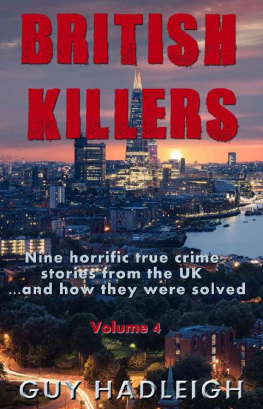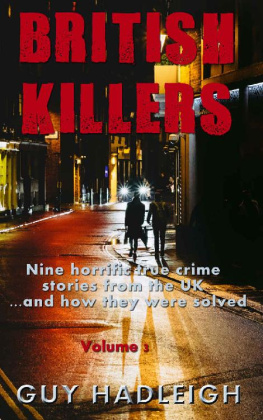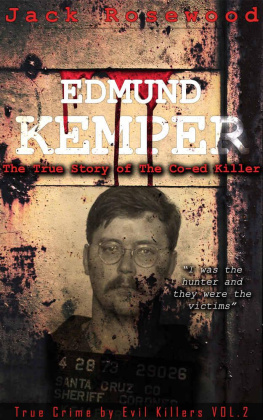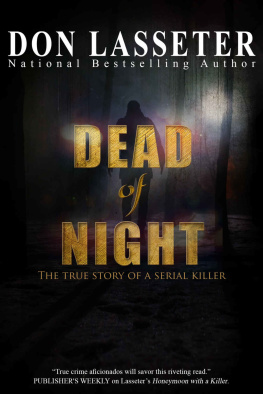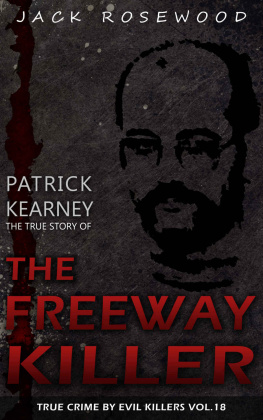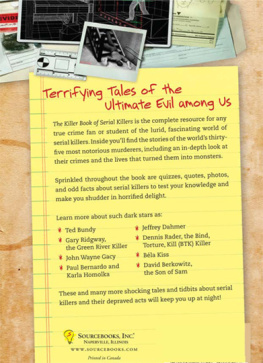BRITISH KILLERS
Nine horrific true crime stories from the UK
and how they were solved
Volume 2
by GUY HADLEIGH
CONTENTS
JOIN MY VIP READERS GROUP AND GET 2 FREE BOOKS
D EAD IN DEVILS DYKE
The late evening streets of Bayswater were thronged with people, despite the chilly February weather, as Janie Shepherd reversed her blue Mini Clubman into a rare parking space in Queensway. Dressed in jeans tucked into Cossack-style leather boots, the striking blonde drew several admiring glances as she locked her car and strolled through the doors of the Europa supermarket.
The 24-year-old Australian was on her way to spend the weekend with her boyfriend at his flat in Knightsbridge. Just before she had set off on the 20-minute journey from her home in St John's Wood, he had phoned to ask her to pick up some groceries for supper.
Although Janie was a visitor to the UK she knew west London well. Among the restaurants that lined Queensway were supermarkets and delicatessens that always stayed open late and it was only a short diversion from her normal route.
It was about 9pm on Friday 4 February 1977 when Janie paid at the checkout for cheese, tomatoes, celery and a couple of smoked trout, and left the store.
At about 9.30 Janie's boyfriend, Middlesex county cricketer Roddy Kinkead-Weekes, telephoned the flat in St John's Wood, where Janie lived with her cousin Camilla Sampson and her husband, to find out if she had left. He was told that she had set off less than an hour before. Kinkead-Weekes was not unduly worried. Traffic could be dreadful in west London on a Friday night.
As it grew later, however, he became more anxious. At about midnight he started ringing the police and hospital casualty wards to see if there had been an accident. There was no news. Finally at 3.15am he drove to St John's Wood police station and reported Janie missing.
Throughout the weekend Janie's friends grew ever more frantic. Educated, wealthy, self-assured and very much in love with Kinkead-Weekes, Janie was not the sort of young woman prone to erratic behavior.
Kidnapped, or worse?
The police were worried too. Detective Chief Inspector Roger Lewis noted that Janie's family was very wealthy - her stepfather John Darling was Chairman of British Petroleum's Australian division. Had Janie been kidnapped? There had been no ransom demand. The police were struggling for any lead at all. But that was about to change dramatically. On the afternoon of Tuesday 8 February, a police patrol spotted Janie's car. It had been parked on a yellow line in Elgin Crescent, Notting Hill, about a mile from Queensway. The car left detectives in no doubt that this was now a case of murder.
Just before she had vanished Janie had decided to sell the Mini. She had had it professionally cleaned inside and out, and had placed a hand-written 'for sale' notice in the rear window. Now the car looked very different.
A violent struggle
Inside there were signs of a violent struggle. The vinyl sun-roof had been slashed clean through twice. The upholstery and carpets had been roughly scuffed and scratched. On the floor at the rear were the brown leather Cossack boots Janie had worn and her red shoulder bag. On a seat there were traces of blood and semen. Despite the struggle that had obviously taken place in the tiny car, the 'for sale' sign was still taped to the window.
Outside, the paintwork of the three-year-old car was now spattered with mud. The dirt had fountained up the side of the front wings as if the car had been used for rallying or grass-track racing. The car was taken away on a trailer for close forensic examination.
A house-to-house enquiry quickly found a witness who was positive about seeing the car in Elgin Crescent as early as 1.10am on Saturday 5 February.
Janies bag, which had carried a change of clothes, her purse containing about 40, and other items, was now empty save for two receipts. One was from the Europa supermarket; the other was from a self-service garage in Bayswater, which showed that Janie had bought three gallons of four-star petrol before going to the shop. From what was left in the tank, detectives deduced the car had travelled between 75 and 80 miles.
Checks on the wheel arches and tire treads yielded samples of soil that showed that the car had been driven over chalky soil mixed with flinty gravel. There were also traces of leaves, mainly oak, beech and hawthorn.
The case was now taken over by Detective Chief Superintendent Henry Mooney of Scotland Yard's Murder Squad.
From the few facts he now had, Mooney believed Janie had been pounced on as she left the supermarket or very soon after. She had been driven, or forced to drive, some 40 miles outside London to a forest or heath. There, he believed, she had been raped. Although there was no body, Mooney was sure Janie was dead. Her killer had probably concealed her body, and then driven back to west London, where he had dumped the car.
Hopes that the soil pattern might narrow down the search area were dashed when Mooney heard from the experts that much of the Home Counties, in a swathe from the Thames Valley in the west to the Lea Valley in the north east, would produce similar mineral traces.
At this stage Mooney knew he had no choice but to get on with old-fashioned detective work. There were two things that must be done.
The plan of action
Assuming Janie had been abducted in Queensway at 9pm on a Friday, someone must have seen something. Finding witnesses was a priority.
The second step was to look through the criminal intelligence files at the local police stations: Notting Hill, Paddington and Harrow Road. Mooney wanted to find out about all their known sex offenders. He felt sure that whoever had abducted Janie had done this sort of thing before.
When Janie disappeared she was wearing her boots, blue jeans, a man's lumber-jack-style check shirt over a beige cotton roll-neck sweater, and a white heavy-knit three-quarter length cardigan with a reindeer design on it. In her red shoulder bag she carried spare clothes - a red polo-neck sweater, a black sweater and clean underwear. It also contained a tapestry she was making and several balls of colored wool. She was wearing distinctive jewelry, including a Russian wedding ring and a gold Woodstock character from the 'Peanuts cartoon strip on a gold chain, and two other gold rings.
Shopping discovered
The Janie story was now headline news in every national paper, and police mounted huge appeals for witnesses outside the Europa supermarket. Three days after the car was found, items from her shopping were discovered by police in the rear gardens of a nearby street.
As the hunt widened, teams of officers with dogs combed railway embankments, parks and the hundreds of acres of open land known as Wormwood Scrubs at the rear of the famous jail. Divers searched miles of the Grand Union Canal. There were no new leads and no sign of Janie.
If Mooney was right and Janie's abductor had struck before, a careful trawl through the records of sex offences and offenders would at least give his squad a list of likely targets to be investigating until the missing heiress was found.
Numerous files on rapists and sex-killers with links to west London, some going back over 20 years, were brought to Mooney's incident room. He also wanted to scrutinize the files on all unsolved cases in the area. He found something interesting almost straight away.
Horrific knife attacks
In 1970 a 31-year-old man, Barbados-born David Lashley, had been sentenced to 12 years for a series of horrific knifepoint rapes and robberies. The crimes had been committed in the Hammersmith and Shepherds Bush area, which borders Notting Hill. At the height of his reign of terror Lashley had become known in the papers as the 'Beast of Shepherds Bush'. But, in police parlance, it was Lashleys 'MO' - his method of operating - that made Mooney take notice.
Next page


